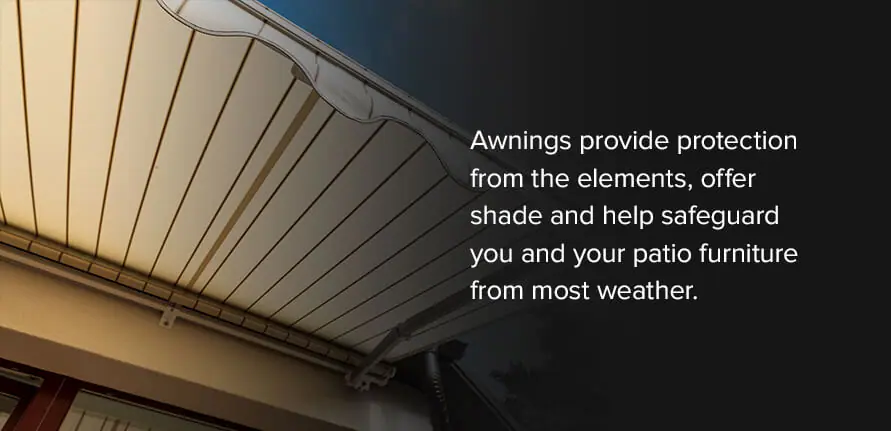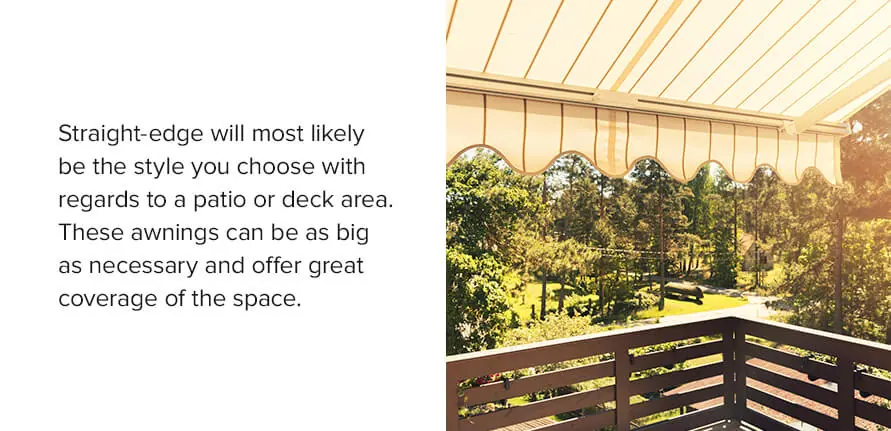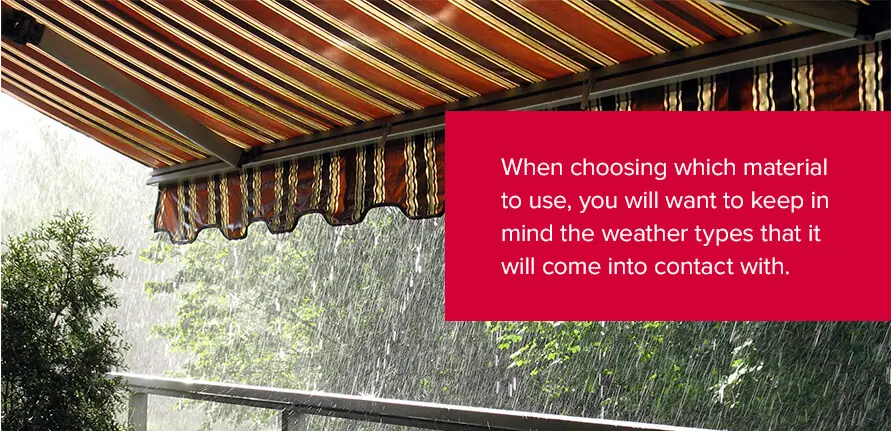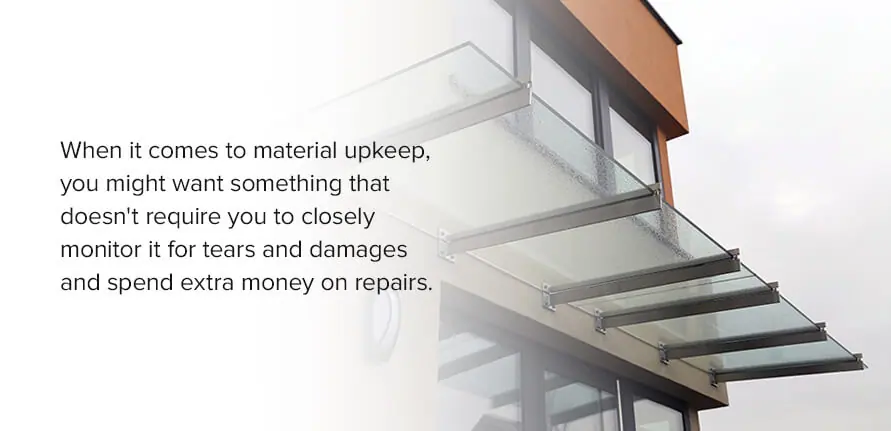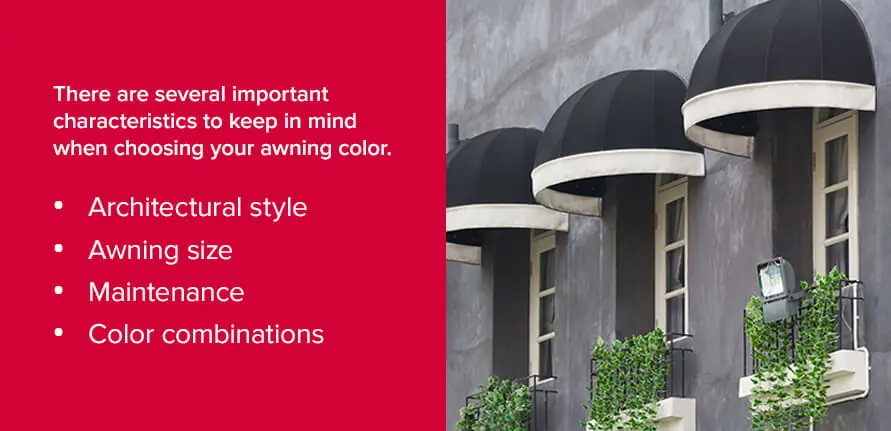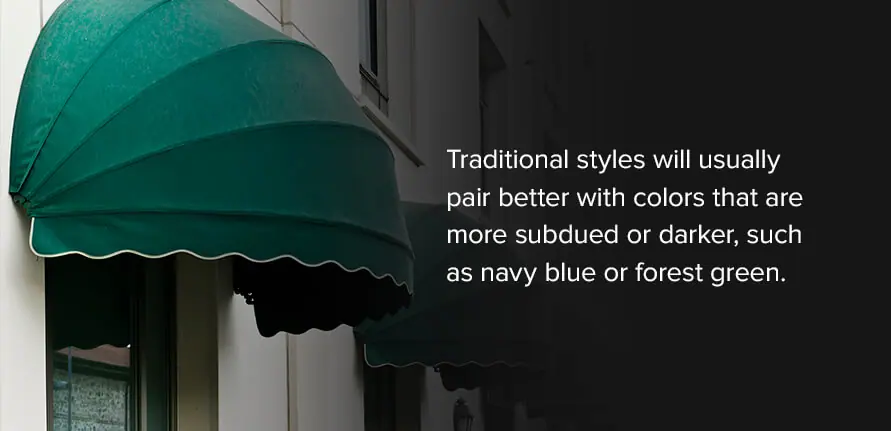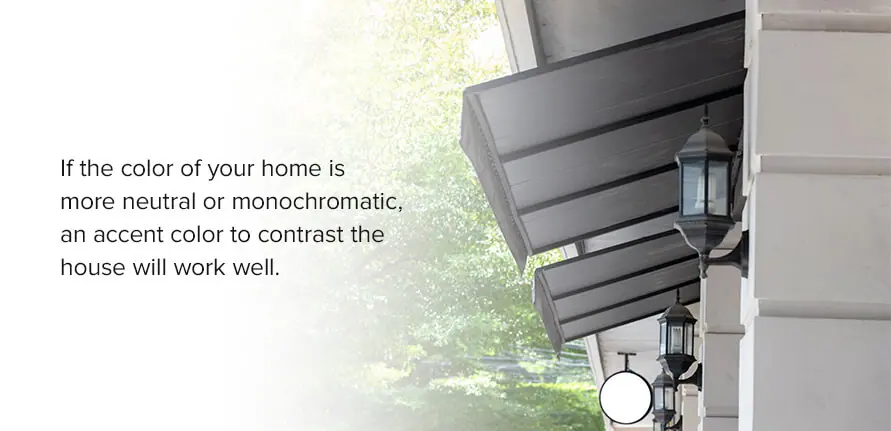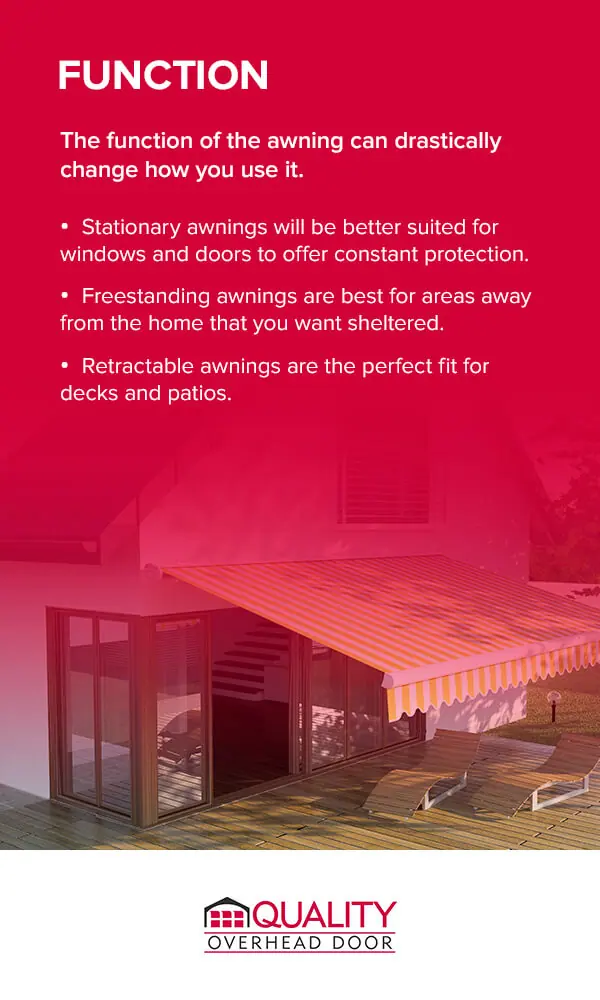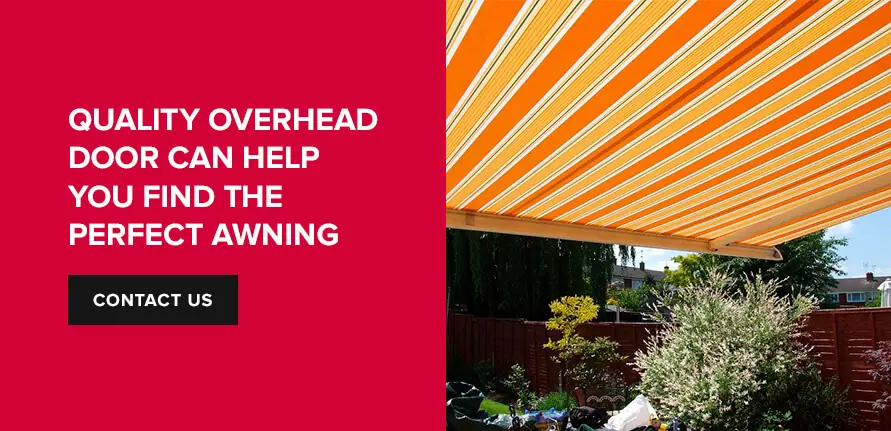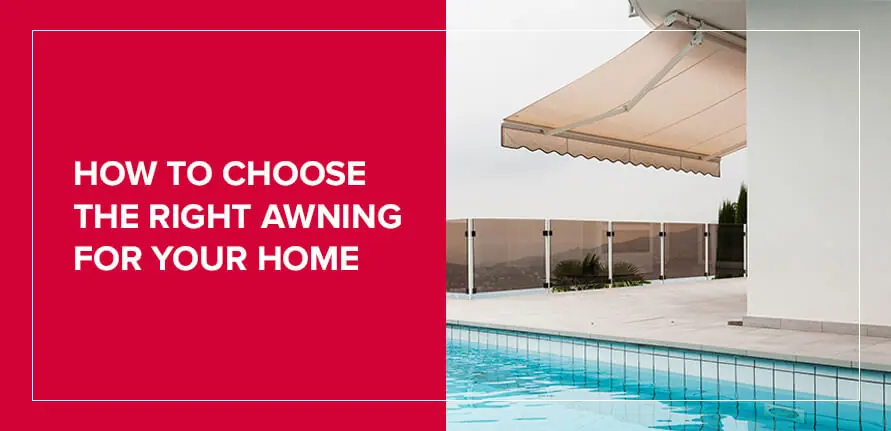
You have this outdoor space, usually a patio or deck, that you want to utilize to its fullest potential. However, the sun is too hot, and the rain always gets in the way. Awnings make the perfect addition for anyone who wants to spend more time outside. They provide shade, protection from the elements and allow you to enjoy the outside year-round. They turn your unprotected patio or deck into a more livable and viable space for you and your family to enjoy. No longer will you have to worry about the weather ruining your evening outside or your patio furniture. An awning will help protect you and your belongings, extending the length of their usage.
Deciding to install an awning is the easy part. Deciding on that perfect awning is the challenging part. With so many options to choose from, you don’t want to make the wrong decision or one that you will regret in the future.
So you may be asking yourself, which awning should I choose? What color? Size? Style? Fabric? To help alleviate the stress, here are a few recommendations to consider when deciding on that perfect awning.
Location
The first decision you will have to make is where you want your awning. Patios and decks are the most common locations. Many people want to sit and relax outside without the worry of sunburning or getting wet. These awnings provide protection from the elements, offer shade and help safeguard you and your patio furniture from most weather.
Although less common, you may also choose to place an awning over your windows and doors. Window and door awnings shelter portions of your house from the weather, keeping your side paneling, windows and exterior doors from damage.
For some people, window and door awnings can keep both the exterior and interior of your house cooler. They provide shade, which makes the space cooler than the surrounding area. Some awnings that you place over doors and windows may decrease cooling costs by up to a 77% reduction. Since awnings are meant to block sunlight from entering a specific area, they reduce the amount of heat that passes through your window.
Style and Edges
You will want to choose a style and edge pattern that compliments the look of your home. Both of these additions will add some extra flair and character, making your home more appealing.
Style
There are multiple different styles to choose from:
- Straight-edge with open or closed sides
- Dome-style
- Waterfall
- Semicircular
- Quarter barrel
- Gable walkway
- Double standard
Some of these styles, such as double standard and gable walkway, are best for commercial or standalone use. These awnings are perfect for locations separate from your home, such as an area for a grill. You can attempt to connect them to your home, but it is usually not recommended.
The other styles, however, have their specific functions. You will find that dome-style, semicircular and waterfall are better suited for window and door coverings. They do not need to expand outward and cover a large space, so they only cover the immediate area instead, namely doorways and windowsills.
Straight-edge will most likely be the style you choose with regards to a patio or deck area. These awnings can be as big as necessary and offer great coverage of the space. You can also customize them to have open and closed sides and more intricate edges.
Edges
An awning’s edge refers to the design of the metal bar. This bar wraps around the front and connects to your home. These edges can come in a variety of styles.
- Scalloped
- Serpentine
- Russian point
- Gothic
Bear in mind that some awnings styles will be unable to accommodate certain edge styles. Likewise, certain homes may look worse with specific edges.
Choosing the right style and edge to match the look of your home is one of the most challenging parts of creating the perfect awning. For most people, it may be best to refer to a specialist. They will better guide you on which styles match your home.
Material
Awnings come in a wide variety of materials. When choosing which material to use, you will want to keep in mind the weather types that it will come into contact with. You should also consider the amount of upkeep and maintenance you are willing to put in. The fabrics, specifically, need more attention than the sturdier materials.
There are several different types of material. First, there are the fabric ones:
- Polyester
- Cotton
- Canvas
- Mesh
Second, there are the sturdier and stiffer materials:
- Aluminum
- Acrylic
- Resin
Before immediately assuming that the aluminum-type awnings are the best, there are a few extra things to consider when making your decision.
Weather
As previously mentioned, the weather that your home experiences impacts your decision on which material to choose. Aluminum, acrylic and resin materials are the best for most people. These materials offer the most resistance to all forms of weather. Aluminum can even keep the covered area cooler by reflecting the sun’s rays. Acrylic and resin give a smoother surface to assist with water runoff.
Fabric, on the other hand, may have a more difficult time resisting water. Unless you opt for a water-resistant material, an optimal angle or a tighter fitting, the fabric can allow water to seep through. Dripping water can easily ruin anyone’s time under the awning. Fabric awnings are perfect for areas that have mostly sunny weather year-round. You won’t have to worry about rain ruining your evening.
Aluminum, acrylic and resin offer the best weather coverage of the material types, while fabric is better for hotter and dryer locations.
Maintenance
When it comes to material upkeep, you might want something that doesn’t require you to closely monitor it for tears and damages and spend extra money on repairs. Again, aluminum, acrylic and resin prove to be the better material here. Since they are harder materials, the possibility of them breaking is slimmer. You might have to worry about acrylic and resin cracking if something happens to hit them just right, which can be costly.
Fabrics are more easily damaged. The wind blows at the right speed and lifts the material upwards like a sail. They can tear if not properly maintained. Fabrics are more prone to their colors fading from sun damage, too.
Customization
Fabrics are by far the better option if you want to customize the look of your home. You can purchase most fabrics in a wide assortment of colors to match your style. Fabrics also work better with most awning operations. You can use them for retractable awnings and all the features associated with them.
Aluminum, acrylic and resin have fewer customization options to choose from. You can only get them in limited colors, and they will not work with retractable awnings. They will stay out permanently.
So, if being able to customize and experiment with the look of your home and awning combination is important to you, then fabrics are by far the superior choice. If you are comfortable with having a permanent awning year-round, then the hardier materials will work better for you.
Color
When someone comes to your home, one of the first things that they will notice is your awning. They will immediately notice the color and how it appears with the color of your house. Therefore, you will want to be sure to pick a color that both matches your personality and compliments the house.
There is no right answer in terms of which color will always match which style, color and size of your house. People’s preferences are never the same, and some may think that going with a lighter blue to match the blue of your house is better than a dark blue. Similarly, most specialists will have their own opinions and color recommendations for you. As there is no immediate right answer, there are several important characteristics to keep in mind when choosing your awning color.
- Architectural style
- Awning size
- Maintenance
- Color combinations
Architectural Style
Houses come in a variety of different architectural styles. Each one has its look and color that best compliments it. Most commonly, houses will have these styles:
- Traditional style
- Southwestern motif
- Cottage style
- Colonial
- Contemporary
The style of your home can affect the color that you choose. Traditional styles will usually pair better with colors that are more subdued or darker, such as navy blue or forest green. You may also choose to use a more monochromatic color scheme, like blacks, grays and whites. Southwestern motif-style homes will pair better with colors in the beige family or ones similar to a salmon. Cottage style and colonial homes have a little more color options to choose from. These homes pair well with reds, greens, dark blues or bolder colors with accent stripes. Contemporary homes will have the most options to choose from as they can benefit from using almost any color combination. These homes already have an interesting design style to them, so a bold, light or subdued color will look good with them.
If you’re less worried about matching with the architectural style of the home, you can always choose a color that compliments the color of your home instead but does not match the color of your home. At the least, you should always choose a color that is either darker or lighter than your home.
Awning Size
The size of your awning will influence the color that you choose. The more coverage the awning has, the more that it will stand out. For bigger awnings, bold and vibrant colors may not be the best option. Having a bright red awning against the black of your house is a great color combination, but having it in abundance from the size of the awning is not so beneficial. Dazzling colors in moderation is key here.
If you have a smaller awning, then you can safely choose to use more vibrant colors.
Fading and Cleanliness
Every color has its specific maintenance requirements. You may want to choose a color that resists fading and hides stains well. You will notice quickly that some colors fade faster than others or stain more easily. Darker colors are more prone to fading and showing stains than lighter colors. That being said, you can buy higher quality bold and dark colors that do a better job at resisting fading.
Color Combinations
It is very easy to choose a color that clashes with the color of your home. Certain color combinations may tempt you to pick them based on their use in public and media. Sports teams, holidays and brands design their logos using appealing color combinations, but you should avoid those combinations as much as possible unless you intend to show support of your favorite team.
To avoid making a decision you may regret, several color recommendations will work well.
Accent colors are your best friend and can draw positive attention to your awning. If the color of your home is more neutral or monochromatic, an accent color to contrast the house will work well. You will want to keep in mind some of the other cautions with an accent color. Try not to choose a color that will be too overbearing or is too similar to the color of your house.
You can also match the color of your home’s interior rather than the exterior. Maybe the room that leads out to the patio has furniture and walls that are a lighter blue. The color of your awning can match the lighter blue or complement that color as well. More likely than not, people will migrate from the interior of your home to the area covered by the awning. The colors will blend well with one another that way.
More than anything, you don’t want your awning to look tacky when next to your home.
Information to Keep in Mind
Lighter colors are better at reflecting light compared to darker colors. They will help keep your space cooler for hotter areas. Alternatively, you can choose to use darker colors for colder areas. The heat absorption can help warm the area slightly.
If you are completely at a loss on what color to choose, you can always pick colors that are in style or matches local design trends. Pantone’s color of the year choices are a great place to go for a starting color.
Angle
The angle of the awning may seem like an odd aspect to consider, but it is an important quality, especially for window and door awnings. All angles will be able to block the sunlight and weather from affecting the covered area, but some angles will prevent more sun, rain and snow from filling the area.
For windows facing east and west, you will want an angle that is about a 65%-75% drop from the top of the window. For windows on the north and south of a home, the angle can be less. Since the sun rises from east to west, you will get less light coming in through the north and south windows, so you can use a 45%-60% drop instead.
Patio and deck awnings can get away with not having any angle, but most experts highly suggest that you give it a slight angle. Fabric awnings can bow in the center, leak with heavy rain and snowfall or break entirely. You will want to give the water some form of runoff to the edges of the awning. With aluminum and sturdier materials, you do not want the water to sit on the top and potentially freeze.
Adding an angle keeps your awning and the area underneath more protected from the weather. You will also have more shade coverage throughout the day than with no angle.
Side Panels
While not the biggest decision, side panels drastically change the look of your awning for the better. Side panels add support around the perimeter of the awning, creating extra stability and more customization options. They provide extra protection against the elements, as long as you have a non-retractable awning. You can also place a screen around the length of the perimeter to offer lasting shade through the day and a barrier against bugs and animals.
Size
The size of your awning will vary, depending on the space being covered. For window and door awnings, you will use a smaller awning. Patio and deck awnings will vary in size. Larger homes will generally need larger awnings to cover the length of the front and back yard. Bigger awnings may limit your options for certain features, styles and materials.
Function
The function of the awning can drastically change how you use it. There are several different operations to choose from when selecting your awning.
- Stationary
- Retractable
- Freestanding
Stationary awnings will be better suited for windows and doors to offer constant protection. They also provide the best resistance and support against extreme weather conditions as they are permanently mounted into the ground. However, being mounted into the ground means you cannot control how much sun or shade you would prefer.
Freestanding awnings are best for areas away from the home that you want sheltered. You can use these areas for family gatherings, tables and chairs, a grill or any other item you want away from your home. You have to mount these awnings into the ground, and you will want to have a sturdier material along the top, preferably aluminum.
Retractable awnings are the perfect fit for decks and patios. You can control the amount of direct sunlight that comes into contact with the designated area, especially in winter when you would not want shade. Fabric will be the only available material to choose from. Unfortunately, that means you have to retract them during extreme weather conditions.
Retractable awnings come with different features and add-ons to choose from.
- Manual
- Button operated
- Sun/weather sensor
- UV protection
Modern technology makes it much easier to use your awning to its fullest potential. At the push of a button, you can have the shade or sun you need without any hassle. Some come with weather sensors to detect when they should retract or expand.
The Awning for You
As you can see, choosing the right awning for your home is no easy feat. The options to consider are numerous. You have to take into consideration color, material, function, location, angle and other aspects.
Our expert team at Quality Overhead Door can help you make the right decision! We’ll help you choose the best awning for your home, answer any of your questions and provide a free estimate. You can explore the options on our website and call us at 419-578-8700.
You can never go wrong with a personalized awning for your home. Why wait? Contact us today and begin enjoying the outdoors again!
Additional Resources on Awnings:
- Common Awning Problems and How to Avoid Them
- Guide to the Different Types of Awnings
- How to Protect Your Patio from the Elements
- Why Retractable Awnings May Be the Perfect Option for Your Patio

